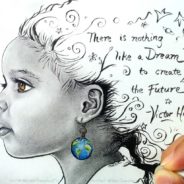Posted by Diane Morrow on July 5, 2007 in Writing about Goals and Vision
To have a vision is risky. To say aloud what one wants—or to dare to write it down—is to take a risk. This seems especially true when one is daring to find words for one’s deeper goals and dreams. And it seems to me that this kind of thing should be acknowledged somewhere at the outset. Two summers ago, my daughter, then fifteen, volunteered for Horse-Sense, a nonprofit organization which then offered horse therapy—the grooming and riding of horses—to children and adults with developmental disabilities. It was a small operation—a pasture, a single riding ring, and a barn—fueled primarily by the sweat and energy of one woman, Kat, a woman whom we met when I first drove my daughter out one Friday afternoon in June. I was impressed that first day by how neat Kat kept the barn, how much she cared about the horses, and also her sense of vision for the place. She walked us around back and showed us trails she was clearing for clients. She told of setting up tables at horse shows on weekends to sell cookbooks and fund-raise. Later, doing chores with my daughter, she told her that she felt that God had called her to do this work. For several weeks my daughter went out once a week, and helped with horse chores. Later, she got an opportunity to work at a clinic, this with a group of children with disabilities who’d ridden up in a yellow school bus from Salisbury, North Carolina. Susan, a behavioral therapist was there, along with a number of volunteers from Kat’s church. Kat and Susan had set up three stations for the clinic. One station in the ring, this where my daughter was working, leading children around the ring on the ponies. Another station where the children were able to groom the ponies. And a third station, this in the shade, where the children were gathered around a table with crayons and paper, drawing pictures. It was hot, but all of the children—and most of the volunteers—seemed to be thoroughly enjoying themselves. There was a sense of purpose and energy. I knew that Kat had moved out to this space less than a year ago, and I knew that she did not yet have the number of clients that she hoped for, but on that particular day, watching the children move through the various stations and then pull out in the school bus, I could see Kat’s vision—the thriving place that she imagined, with the horses at the center and something of value being offered to the children. I was glad that my daughter could be a small part of it. It seemed all good, if tenuous, with the success of the venture resting primarily on Kat’s shoulders. Then, some time in late July, Kat called. My daughter was out. I ended up talking to Kat a bit. “I need to tell you,” she said, “that we’re going to close.” Just like that. In order to keep the place afloat, she said, she really needed at least thirty clients a month. She hadn’t been able to reach those numbers and she’d tried everything she knew and it just wasn’t happening. And just like that. It was over. The risk of vision is failure. This seems to...
read more

